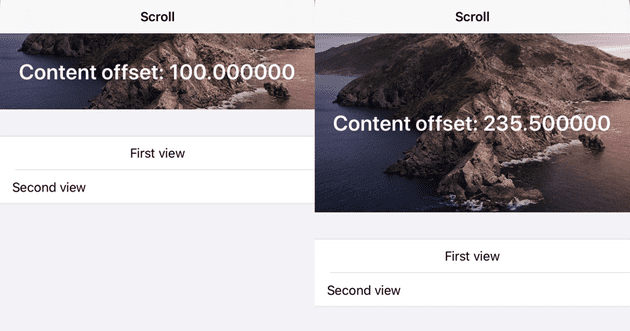SwiftUI doesn’t provide yet a TableHeaderView or something similar to UIScrollViewDelegate but I tried to experiment with different Views to have something close to a stretchable header.

The initial idea is to try to implement a stretchable header that would play well with a List or a Form.
And if I want to describe what I would like to achieve it will have been as simple as this:
struct Example: View {
let minHeight: CGFloat = 200
@State var stretchableHeight: CGFloat = minHeight
var body: some View {
VStack {
StretchableHeader().frame(height: stretchableHeight)
List()
.onScroll { offset in
self.strechableHeader = max(minHeight, minHeight + offset.y)
}
}
}
}Not that simple
Unfortunately this doesn’t work, we don’t have an extension of View with a ViewModifier onScroll which will help us achieve our goal. Even if we did have this, I’m not sure if it will play nicely because we are mutating the height of the StretchableHeader from List.
The key is to use PreferenceKey
Finally got something! Wanted to play with "stretchy" header in a scroll view with #SwiftUI. The key is.. preferenceKey! Still needs a lot of tweaks but it's good to see some progress. #ScrollView #ContentOffset #PreferenceKey pic.twitter.com/cunjfBLD65
— Thomas Sivilay (@thomassivilay) August 13, 2019
After some research and not finding much help, there is actually one blog that helped a lot in this experimentation: SwiftUI-Lab
And they will probably soon share how to achieve similar goal, hopefully in a more complete way:
Here's another example of the #SwiftUI PreferenceKey protocol in action. Maybe one day ScrollView will support refresh controls natively... until then, here's my first approximation. Blog post + source code coming soon. First I need to do some cleanup. pic.twitter.com/CbcymKTyIG
— The SwiftUI Lab (@SwiftUILab) August 16, 2019
Anyway, PreferenceKey was what helped me having something closer to the initial goal, you can read about it in this article
I use PreferenceKey as a way to share some values between Views that share the same ancestors. So in this example the value that I want to share is “what is the offset on the scroll” from the List to the StretchableHeader.
Some solution
Instead of embedding everything in a VStack, the first change is to use a ZStack so we can have the StretchableHeader to be displayed on top of the ScrollViewContentView. We also need to adjust the offset of the content based on the height of header.
We use @State as our local variable to capture both the current offset of the scroll and the default height of the header.
struct Example: View {
@State var yOffset: CGFloat = 0
let headerHeight: CGFloat = 100
var body: some View {
ZStack {
StretchableHeader(offset: $yOffset, headerHeight: headerHeight)
.zIndex(2)
ScrollViewContentView(offset: $yOffset)
.offset(y: headerHeight)
}
.onPreferenceChange(ScrollOffsetPreferenceKey.self) {
self.yOffset = $0.first ?? 0
}
}
}Breaking this example into two View brings more clarity but involve injecting the state as a @Binding.
struct StretchableHeader: View {
@Binding var yOffset: CGFloat
let headerHeight: CGFloat
var body: some View {
GeometryReader { proxy -> AnyView in
return AnyView(
ZStack {
Image(“catalina”)
.frame(height: max(self.yOffset, self. headerHeight))
.clipped()
Text(“Content offset: \(self.offset)”)
}
.frame(width: proxy.size.width, height: max(self.yOffset, self.headerHeight))
.clipped()
)
}
}
}We use GeometryReader to have access to a GeometryProxy to help us defining the exact frame of the StretchableHeader where we keep its width but set the height to use the yOffset so that the content will grow.
Earlier, we said we will use a PreferenceKey to define and share the data representing the scroll offset.
struct ScrollOffsetPreferenceKey: PreferenceKey, Equatable {
static var defaultValue: [CGFloat] = []
static func reduce(value: inout [CGFloat], nextValue: () -> [CGFloat]) {
value.append(contentsOf: nextValue())
}
}Which is already listened/handled in the ExampleView with:
@inlinable public func onPreferenceChange<K>(_ key: K.Type = K.self, perform action: @escaping (K.Value) -> Void) -> some View where K : PreferenceKey, K.Value : EquatableBut needs to be mutated in ScrollViewContentView using:
@inlinable public func preference<K>(key _: K.Type = K.self, value: K.Value) -> some View where K : PreferenceKeyThe way I choose to update the PreferenceKey values if by finding the minY value of the first view inside ScrollViewContentView.
struct ScrollViewContentView: View {
let correction: CGFloat = 85 + 44
@Binding var offset: CGFloat
var body: some View {
GeometryReader { proxy -> AnyView in
return AnyView(
Form {
GeometryReader { firstViewProxy in
Text(“First view”)
.preference(key: ScrollOffsetPreferenceKey.self,
value: [firstViewProxy.frame(in: .global).minY - self.correction])
}
Text(“Second view”)
}
.frame(width: proxy.size.width)
)
}
}
}Again GeometryReader help us finding the minY which we use as a value update of ScrollOffsetPreferenceKey.
Known issues
Correction for navigation bar height
Maybe you noticed that in the ScrollViewContentView there is a correction value, which I’m not comfortable with and needs to change based on the displayMode of a .navigationBarTitle.
Large title isn’t my friend
With a large title, we will need to modify the offset of the StretchableHeader based on the scrollOffset but by doing so we will again update the scrollOffset.. Then we have a nice infinite loop.
Using first view isn’t a good idea
Using the first view to update the preference value might work for our example here, it will also play nicely if we want to have a refresh control in the stretchable header. But if we have a bigger header height, you can find some issues where we are not updating the preference key values anymore. I believe it’s because of the first view not being on the screen which will not relay frame changes anymore!
So what’s next?
That was just some experimentation that I wanted to share, definitely not something I recommend but some ideas to that could be use to improve and solve the initial goal. Without much documentation and using SwiftUI at the early stage, we do with what we have and the most important is that I had fun and learned more about GeometryReader and PreferenceKey trying this.